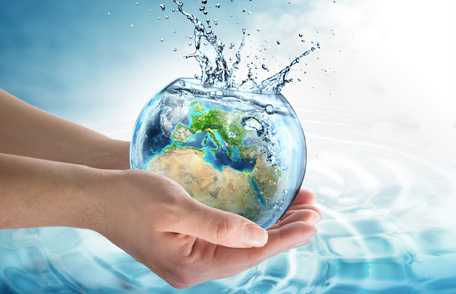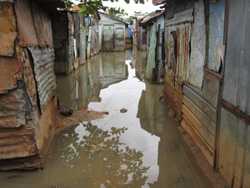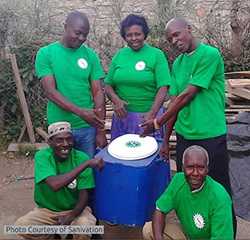World Water Day 2017
 World Water Day is observed each year on March 22 to promote the responsible use of water and access to safe water for everyone. One in 10 people around the world still do not have a safe water supply close to home1.
World Water Day is observed each year on March 22 to promote the responsible use of water and access to safe water for everyone. One in 10 people around the world still do not have a safe water supply close to home1.
Water is one of our most important natural resources. Every day, people, animals, and plants depend on water for their survival. Water is necessary for food growth, energy production, individual well-being, and global health. Nearly half of workers around the world (1.5 billion people) have jobs related to water2. Many industries rely on water for their survival as well, including fishing, agriculture, manufacturing, and food service.
Reducing Wastewater
This year’s World Water Day theme focuses on wastewater, which includes sewage, storm water, and unused water in the community3. Many underdeveloped countries are not able to properly manage wastewater due to limited resources, technology, and space. Wastewater in low-income countries is rarely treated or disinfected before being put directly into rivers, lakes, or oceans. This pollutes the environment and increases the chance for people to get sick4.
One of the targets of the World Health Organization’s Sustainable Development Goal 6, which is to ensure access to water and sanitation for all, focuses on reducing the amount of untreated wastewater by half and increasing the recycling and safe reuse of water around the world by 20305.
Now is the time to address these challenges to keep the global water supply safe and available for generations to come.
Visit the United Nations’ World Water Day website for more information on World Water Day and ideas on how to get involved.

Many cities in developing countries do not have adequate infrastructure and resources to properly manage wastewater in an efficient and sustainable way.
World Water Day also presents an opportunity to learn about water-related issues that affect us locally. For more information about CDC’s water-related public health efforts in the United States, visit CDC’s Drinking Water, Water, Sanitation, and Hygiene-Related Emergency, and Healthy Swimming websites.
CDC’s Global Water, Sanitation, and Hygiene (WASH) Expertise
Since 1990, the number of people who have access to safe drinking water sources and sanitation facilities (latrines or toilets) has increased by 2.6 billion and 2.1 billion, respectively1. Despite these gains, hundreds of millions of people still do not have access to these basic human and public health necessities. Lack of access to drinking water and sanitation increases the chance for waterborne diseases like cholera and typhoid fever to spread1.
CDC’s Global WASH group works with other U.S. government agencies, foreign Ministries of Health, non-governmental organizations, the United Nations, private companies, and various international agencies. The partnerships help to improve global access to healthy and safe water, proper sanitation, and hygiene.

Sanivation team showcasing a portable toilet.
Story from the Field: Sanivation
CDC is committed to increasing access to sanitation facilities, especially in underdeveloped countries with limited resources. When a start-up group of recent university graduates approached CDC with an innovative idea—to provide toilets for households in need and use the human waste to make fuel—a new, collaborative partnership began.
Established in 2011, Sanivation installs locally manufactured container-based toilets in Kenyan households to people who pay a small monthly fee that guarantees on-call and twice weekly visits by service representatives. Sanivation representatives collect the waste and treat it with solar thermal energy to create low-cost briquettes, similar to compressed charcoal or coal, for cooking and heating homes.
CDC staff helped Sanivation examine how well and under what conditions (such as temperature and time) solar thermal treatment kills the germs in human waste. With additional support from CDC and USAID, Sanivation plans to expand its waste collection and treatment services to institutional and other waste streams, making the environment safer for the entire community. Innovative public-private partnerships such as this are critical for continued improvements in access to sanitation and hygiene services across the globe.
References
- UNICEF and World Health Organization. Progress on Sanitation and Drinking Water—2015 Update and MDG Assessment. Geneva, Switzerland: World Health Organization; 2015.
- World Water Day website
- United Nations. Environmental Indicators: Inland Water Resources, Wastewater. United Nations; March 2011.
- United Nations. Wastewater Management—A UN-Water Analytical Brief. United Nations; 2016.
- United Nations. Goal 6: Ensure Access to Water and Sanitation for All. United Nations; 2016.
More Information
More Information
- Page last reviewed: March 21, 2017
- Page last updated: March 21, 2017
- Content source:
- National Center for Emerging and Zoonotic Infectious Diseases, Division of Foodborne, Waterborne, and Environmental Diseases
- Page maintained by: Office of the Associate Director for Communication, Digital Media Branch, Division of Public Affairs




 ShareCompartir
ShareCompartir